#worship of linga and yoni
Explore tagged Tumblr posts
Text
Sacred Sexuality: Honoring Yoni and Lingam in Tantric Union
The sacres essence of Tantric sex and its original purpose have been overshadowed by the constant presence of sexual imagery in the media. We encounter these images daily on television, in magazines, and online. On TV shows, sex often dominates the narrative, appearing in jokes and conversations. Many modern therapists argue that sex is a biological necessity and essential for happiness.…
#importance of tantric sex#tantra sex#tantra sexuality and spirituality#tantra spiritualität und sex#Tantric Sex#what makes sex sacred#why is sex not sacred anymore#why is sex sacred for human beings#why is sex so sacred#why sex is sacred and spiritual#worship of linga and yoni#yoni worship in india#yoni worship mantra
7 notes
·
View notes
Text


That is why we find even when we are worshipping the Mother Goddess, Shiva is always there in the background. Because they are a couple and without their union, creation is not possible. In the vigraha, the union of Shiva and Shakti is represented in the form of ardhanārīshwar where the right side of the body is Shiva and the left side, Devi or Parvati. They are one and inseparable. ~ Ardhnarishwara at Darasuram
Dance of Shiva and Shakti Talon Abraxas
Shakti is Energy and Shiva is Consciousness and together they make up this Jagat or creation. That is why they are married. Shiva is husband; Shakti, the wife. The universe is the result of their union. That is why one of the most revered and powerful symbols in Sanatana Dharma is the Shiva linga embedded in the yoni, which is a representation of the union of Shiva and Shakti.
The union of Shiva and Shakti is the knot that ties together the stars (the universe). The connection between the two is one of abhinna bhava sambandha, i.e., non-separation. They are the male and female aspects of the same Unity which is neither male nor female.
27 notes
·
View notes
Note
Hey! I am not a hindu scholar but I have some doubts regarding shivling. I know it's obviously not any vulgar thing but can you please eloborate why it is called "ling". It is often used to bash hindus and troll them for worshipping a "male organ" and call them andhbhakts who worship a stone .
If you haven't seen the latest trolls on mahashivratri, take a look.



I know this already, I had been researching about this since mahashivratri and I found a legit answer. Many articles have manipulated a simple logic behind it to throw a shade at hindus who follow shaivism.
It is NOT EMBEDDED IN YONI, neither it is any male organ.
‘Shivling’ is a Sanskrit word which means ‘symbol/ representation of Shiva’ as the word ‘ling’ translates to ‘symbol/ representation’ only. Whereas ‘yoni’ translates to womb/vagina/species and 'shishin’ translates to penis , not 'linga’.
People think that it shows union of male and female genitals. But in reality , it shows none of them.
Below are the logical proofs-
A) Proof that it is NOT a male organ-
Jyotirlingas are the 12 most sacred and absolutely true Shivalingas because they are not man-made, they are made by Shiva himself. So these Shivalingas are prefect.
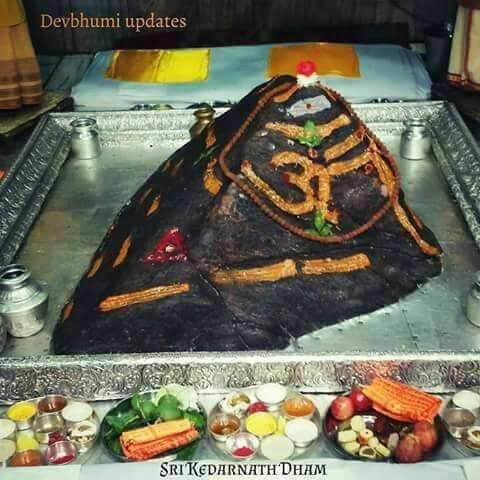
The above image is of Kedaarnaath JyotirLINGA . The word ‘linga’ is used , but does it looks like any male organ?
No, because it is NOT a male organ. Carefully observe it , it looks like Mount Kailash ; then also ‘linga’ is used because ‘linga’ just means ‘symbol’ and has no relation with any body part.
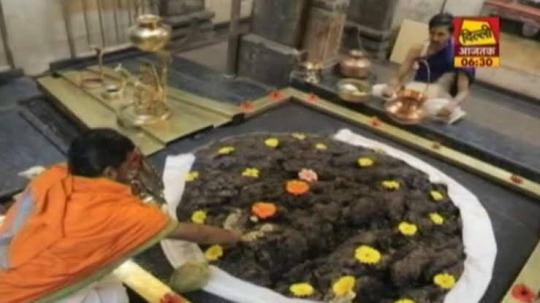
This is another naturally formed Shivling named Mahabaleshwar Shivling. Observe again ,it doesn’t looks like any organ , because it is not. This shape of Shivlinga represents the irregular shaped form of Shiva ( Shiva has many forms)
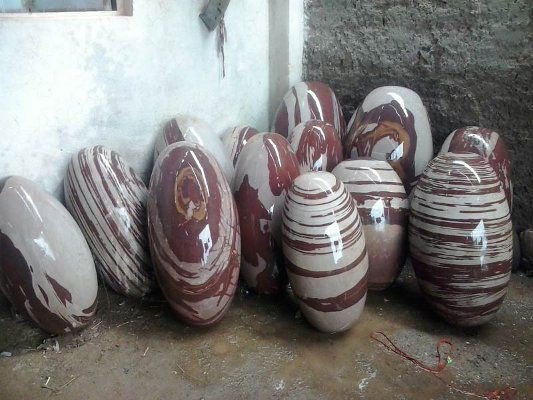
These are the naturally formed Narmada Shivlings. Look at their shape , they are ellipsoid. Male genital doesn’t look like it.
These are the most popular type of Shivlingas.
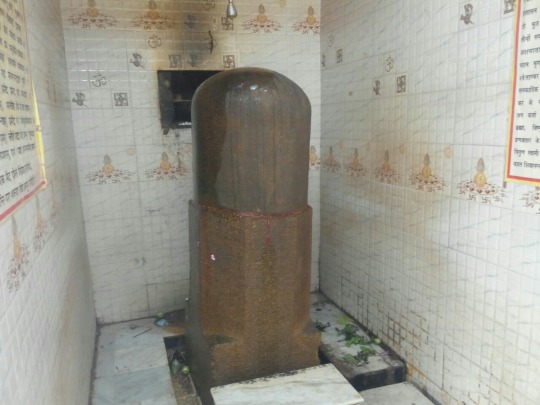
These kind of Shivlings (Such shaped Shivlings represent infinitely long light pillar shape of Shiva , which Shiva took resolve the arguments between Vishnu and Brahma) can also bee seen in temples and they don not look like any male organ since middle part of Shivling is octagonal and the base is square. Which human organ is octagonal ?
B) Proof that it is NOT embedded in yoni-
The base/ pedestal which uphold the Shivling is mistaken as yoni
Now please scroll up and look at the base of the above mentioned Shivlingas , they all are square shaped . And yoni is not square.
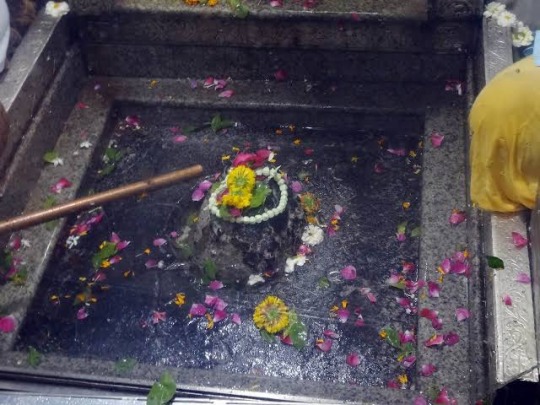
This is Omkareshwar Jyotirlinga , observe the base around it , again it is square shaped.
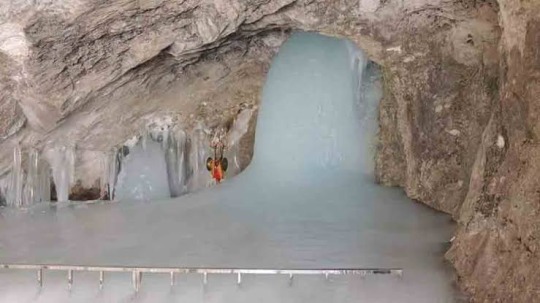
This is Amarnath Shivling , here there is no base/pedestal, only Shivling.
So this is the proof that Shivling neither show male nor female bodypart.
C) So if Shivling doesn’t shows any bodypart then why it is in such shape?

This form is only of a point light. This form of Shiva is known as ‘Paramaatmaa’( Supreme-Soul) form so ancient saints imagined this form as a small light flame and they made it into stone .
Now check the shape of small light flame

same shape as shivling:

Such shaped Shivlings are most common Even some of the Jyotirlingas are of similar shape.
D) Then why pedestal is important?
Pedestal/ base is used only for three purposes-
To provide water drainage in one direction , hence keeping the nearby area clean.
To provide stability to the ellipsoid shivling
To keep shivling vertical , because light flame is always vertical. Nothing more than this.
Therefore in Amarnath Shivling it is not there because all the three points are fulfilled by nature itself.
E1) Some more proofs-
Calling Shivling as a symbol of creation by union of male-female is senseless, because these rocks , mountains , oceans etc . cant be made by male-female union. So by being human organs, it can’t symbolise universal creation. And there are organisms which reproduce without mating (male-female union).
E2) Scriptural proof -
Shiv Lingaashtakam is a prayer written specifically for Shivling by Adi Shankaracharya. And if you read it, its last line says-Sanskrit -’’Paraath Param Paramaatmak Lingam, tat-Parnamaami Sadaa Shivlingam ” which says that Shivling is representation of Supreme-Soul (Paramatmak) form of Shiva.
And ———
Shiv Puran (Gita press Hindi) : Book page number- 41–44; speaks about infinitely long bright light pillar called symbol (linga) of Shiva. And it does not say anything related to human organ
So this proves that true Shivlings do not represent any human organ.
Answer source and credits 💐 - https://qr.ae/pvYj8I
One thing to note , we call shivlinga a “pinda” so its obviously not any reproductive male organ.
#hindublr#desiblr#desi#desi tag#india#hinduism#hindu gods#sanskrit#desi tales#desi tumblr#hindu mythology#mythological#history#archaeology#architecture#indian mythology#indie moodboard
247 notes
·
View notes
Text

Religious Studies Term Of The Day: Yoni
Hey everyone. So, to close off my Hinduism talks (for now) I wanted to talk about the yoni. Yoni is the female genital organ, what we would call a vagina in English. I know that some people talk about “pussy worship,” but like the Hindus have had religious significance of the Yoni for a long time. Like, I’ve been to a religious ritual where they have a linga, which represents Shiva’s genitalia, but it is always paired with a Yoni. In fact, people even worship the goddess at a temple in Kamarupa where her Yoni is depicted in a cave. The yoni is a common motif in Hinduism, although mostly with Shiva’s linga. (By the way, cool ritual, I will say. It was wonderful to watch at my local temple). But the point of it is not to literally worship vaginas. It’s meant to point to the ability to create life, the ability for a woman to create a living creature inside her body is seen as a divine power, even if, sadly, the male vitality is more appreciated and the bigger focus. But seriously, I recommend checking out your local Hindu temple to see the idol of Shiva’s linga and the goddess’s yoni and getting to see how much these faithful people care for it. But I am just one man who knows a very surface level knowledge about yoni, so I’m open to more viewpoints. But for now, I hope you’re all staying safe and having a great day.
#religiousstudies#religious studies#religion#religiousliteracy#religions#hinduism#hindu#hindus#hindu culture#hindureligion#women and religious traditions#leona m anderson#Pamela Dicky young#oxford#factoftheday#factsdaily#fun facts#yoni#linga#female#genital#organ
8 notes
·
View notes
Text
Preceding with Sakti
The philosophical underpinnings of Sakti, the All-pervading Energy.
NOTHING can exist unless there is some ground for its existence, some substratum from which it may rise. There must also be some possibility and some reason for existence. We have seen that the universal substatum was called the Immensity (brahman) and that the mechanical potentiality of manifestation lay in the form of opposing tendencies represented as cohesion (Vişnu) and disintegration (Śiva), their balance, the space-time creating principle, being known as the Immense-Being (Brahmā).
The tension between the opposites from which motion arises in the substratum is depicted as the first appearance of energy (sakti). It is from manifest energy, and not merely from the opposition from which it springs forth, that existence arises. Energy does not pertain to one or the other of the opposites nor to their opposition. It is something more, something new. Once manifestation has taken place, it appears as the substance of everything, pervading every thing. It can be represented as the power of Siva or that of Visnu or that of Brahma. As the power of their combined form, Isvara, it becomes the Supreme Goddess (Bhagavati), the Resplendent-One (Devi). It can even be conceived as the power which appears in the neutral Immensity, as the maelstrom from which existence and the three basic-tendencies (gunas) themselves appear to arise; it is then called Illusion (Maya). From the point of view of cosmology this power, when manifest, it is called Nature (prakṛti). It is through it that the gods are born and procreate, Energy is pictured as female, being the creative birth giving aspect of divinity, the power through which creation manifests. It is only when the qualityless, shapeless, substratum becomes: "The quality of being divine, appearing in that in which there is most energy." powerful beings, rest upon that of power. The gods are infused through and through by the great Energy. A limitless center from which the universe can be created, maintained, and destroyed. Without energy, Siva, the lord of sleep, is unable to create or destroy, He is as powerless as a corpse. The divinity of divinity rests upon Energy. "She is the power of the Self; she it is who creates appearances." In the Linga-arcana Tantra we read: "Devoid of senses, the eternal lord of sleep is merely the form of the Void. He has no visible form. What can be expected from the worship of nothingness?
"Without the great Daughter-of-the-Mountain (Parvati), ever glorified as his supreme dread energy, the corpse of Rudra is never worshiped. This primordial goddess is known as "the coiled, Kundalini". Her substance is Brahma-Vişnu-Šiva. She envelops Šiva with her three and a half veils. Only because he is united with Energy is the eternal lord of sleep a doer of actions. This is why the Goddess is worshiped as a linga surrounded by a yoni." "The quiescent aspect of Siva is, by definition, inert. Activity is the nature of Nature (prakṛti). For this reason the female form is represented in sexual union as being above (vipartta) the male. When the devi is shown standing above Siva... [this also represents] the liberating aspect of the Mother." (Woodroffe, The Serpent Power, p. 27)
Among the Saktas, who are the worshipers of the Goddess, the source of existence is considered female, becomes the main representation of divinity is God as woman.
Yet power is ever inseparable from him who possesses it. So the all-powerful Energy cannot be really distinct from the substratum from which it arises. The concept of Sakti is necessary to justify the appearance of the perceptible universe out of an inaccessible, motionless substratum.
The word Sakti, meaning "energy," is found in the Vedas, where its equivalent is in fact (divine grace), representing Energy, personified as the consort of Indra, the divine might. The notion of Sakti as the supreme power seems to appear fully only in the Svetasvatara Upanisad, one of the Saivite Upanisads.
In the common Hindu theology, Sakti is but another name for the manifesting power, the creative principle. It takes the place of Brahma, the Cosmic Embryo (Hiranya-garbha). In later mythology the concept of Sakti comes to include both the notions of a concentrating and illuminating the power that is Vişņu and an active space-time principle that is Brahma to form the complement of the male, positive, ultimate knowledge that is Śiva.
Descending from the earliest prehistoric Saivism, the eternal couple Šiva and the all-pervading Energy Sakti is represented in the male and the female emblems, the linga and the yoni, pervades the whole of later Hinduism. The linga embraced by the yoni forms the central object of worship and tends to reduce to a minor position all the other ways of representing divinity.
Energy is the source of everything, the origin of the phenomenal world but also of the conscious plan of its creation, and the principle of knowledge or perception through which its existence, real or apparent, can be known. Thus the Goddess is also represented as Consciousness or as Knowledge. Without her the gods are dead, inactive, unknown, nonexistent. Knowledge (jana) without action (kriya) is dead knowledge, and so is feeling (rasa) without strength (bala).
The Goddess is the source of all, the universal creator. "The gods, approaching the resplendent Goddess, asked her, 'Who are you?' The Goddess replied, 'I am the form of the Immensity; from me the world arises as Nature and Person (prakṛti-purusa)." (Devi Upanisad 1-2 [478])
"She is the form of all that is conscious. The origin, the knowledge, the perception of reality, the instigator of intellect." (Devi Bhagavata Purāņa 1.1. [479])
She is realized in the microcosm as the ultimate goal of Yoga.
"In the principial-aperture (the brahma-randhra, behind the forehead) each man finds me, the lady-of-the-spheres (Bhuvaneśvari), who am the shape of the Principle, beyond the Fourth [unmanifest] stage." (Bhuvanesvart Upanisad. [480])
The Devi Sukta of the Rg Veda describes her as supreme, all-pervading divinity.
The Goddess says:
"I wander with the principles-of-life (Rudras), with the spheres-of-existence (Vasus), the sovereign-principles (Adityas), and the all-pervading-gods (Viśvadevas). I am the support of Might (Indra), of Fire (Agni), of the law-of Asvins). I am the support of the soma wine which flows from the crushing man-and-gods (Mitra-Varuna), of the horse-headed gods-of-agriculture (the stone; I am the support of the Shaper (Tvaştr), of the Nourisher (Paşan), of the Inherited-Share (Bhaga). I am the giver of the fruit of action to the performer of the ritual sacrifice, which nourishes the gods with offerings. "I am the Kingdom, the giver of wealth, the knower of the essence of things. I come first in all rituals. The gods have established me in various abodes. My sphere is wide. I dwell in all things.
"From me comes the food you eat, all that you see, all that has breath (prāna), and all the words you hear. Those who do not acknowledge me are destroyed. Study and hear what I say with respect. I am the pleasure of gods and men".
"I make everyone whatever he wishes to be, feared or great, a man of vision or intellect. I draw the bow of the lord-of-tears (Rudra) to kill the tribes of the enemies of knowledge. I fight for the people. I enter the sky and the earth. I give birth to the father and I am his head. I spring forth from the waters of the ocean. From there I spread into the universe. I touch the sky with my body. I blow like the wind, creating the worlds. My greatness expands beyond the sky and the earth." (Rg Veda 10.125.1-8. [481])
As the source, the plan of the universe, Energy first appears as a consciousness. Knowledge, that is, the perception of the existing universe, is its manifest form. There is a conscious plan for everything and therefore a possibility of knowing, a knowledge related to everything. The knowledge of the universe is the transcendent-knowledge (maha-vidya), whose form is identical to that of the all-powerful Goddess, and fragments of which are expressed in the revealed scripture, the Veda.
The knowledge of the cosmos is called virat-vidya; that of the manifest universe is visva-vidya. The main aspects of existence as perceived from the point of view of man are represented in the ten forms of the Goddess, the ten objects-of-transcendent-knowledge (maha-vidyā, महाविद्या) which are her most commonly worshiped aspects. Mahavidyas are usually named in the following sequence: Kali, Tara, Tripura Sundari, Bhuvaneshvari, Bhairavi , ChhinNamasta, Dhumavati, Bagalamukhi, Matangi and Kamala. Nevertheless the formation of this group encompass divergent and varied religious traditions that include yogini worship, Saivism, Vaishnavism, and Vajrayana Buddhism.

8 notes
·
View notes
Text
Wednesday, March 22
Rode out to a UNESCO site called My Son, or beautiful mountain. It is where the Cham people used to worship. The area was devoted to God and just like in Peru, no materials from the site were used to create the structures. Only the highest of rank were able to go into the temples and make an offering. Very focused on the linga (male) and yoni (female).





It's SOOOO HOT ~ 98 degrees and humid. This area surrounded by mountains was headquarters for the Viet Cong and was almost impenetrable for the South Vietnamese forces. There are many bomb craters from American planes that are visible in the area. There was much damage to this sacred place, but it was the only way that the area could be attacked.
We keep remembering that soldiers were wearing full gear, trudging packs and marching fearfully through these jungles in the desperate heat and heavy monsoon rains. Days and nights on end. Impossible. Aaron is definitely going to connect with his maple syrup friend and vet, Hank, when he returns home. He thinks he'll connect with Rick as well.

There was a performance of traditional Cham dance and music. The trumpet player was able to play on and on with what Aaron says is circular breathing (breathing in and out at the same time). Never seen anything like it.



2 notes
·
View notes
Text
excerpts from an article written by swathi s. nair, dated 28th november 2019.
tw: mentions of queerphobia, violence against lgbtqia+ in the last three excerpts.
back in 200 A.D, various temples across India had sex sculptures carved into their walls. sun temple is one such place in Konark, a city in the state of odisha. the sun temple of Konark is a holistic place with depictions of sexual acts that involve polygamy, lesbian relationships, polyandry, and more. all the fallen down sculptures and walls have been preserved in the nearby Konark Archeological Museum.
“Kamasutra, the book of love was taught to young students back in the days and this was one of the pictorial media of education for young students then.” says Suryamani Malla, tourist guide from department of tourism, who has extensively researched about the sun temple of Konark.
section 377 of Indian Penal Code (IPC) states: “unnatural offenses- whoever voluntarily has carnal intercourse against the order of nature with any man, woman or animal shall be punished with imprisonment for life, or with imprisonment of either description for a term which may extend to ten years and shall also be liable to fine.”
this law was decriminalized on 6th september 2018. it was a huge step in the right direction, but for a country who has homosexual sex sculptures on the walls of the most sacred temples, this should have never been a ‘criminal offence’.
other than the Konark temple, the best preserved of all temples can be found in a small town named khajuraho in the central state of madhya pradesh. Khajuraho temples were built in the Chandela dynasty between 950 A.D and 1050 A.D. the sculptures portray homosexuality and are depicted right next to sculptures of divine beings smiling blissfully at their devotees.
apart from all this, Hinduism is a religion that has traditionally considered sex an essential part of life. that could be one of the reasons why these carvings are casually scattered between others that portray activities such as prayer and war. the fact that they are set in plain view and not tucked away in the extreme corner tells that their creators meant for them to be seen by all. “if you take Kamasutra itself, there is an entire chapter that talks about homosexuality. where they talk and clearly categorize all kinds of homosexual desires. the author talks about these desires as perfectly normal and as a possibility. he did not portray it to be a moral issue or a social/religious taboo.” says jithin shankar, who is an assistant professor of History at NSS Hindu College, Kerala.
the reason why concept like homosexuality has become subjective is because people either address it to be right or wrong. the literature available tells you that having a sexual preference tis more of a grey area, hence multiple versions of the same thing. at some point in time, homosexuality collided with religion and that is when people started questioning the ethics and morality of this subject.
religion is just a discipline which tells people what to do and what not to do. there have been multiple cults throughout history before religion came into picture in this country. there have been various cults that worship sexual organs like Linga worship or Yoni worship during the Indus Valley Civilization. this gives it a spiritual entity.
many characters in Indian mythology literature like Mahabharata and Puranas talk about characters like Mohini and Shikhandi, who can be categorized as bisexual or gender variant and this shows how normal it was back then to include characters like this to the literature. “instead of getting inspired by the character, even the fact that people had the imagination to write down a character like her, is a big step. they had the literary freedom when it came to this” says Shankar. shankar points out that during that time and age, even the European literature did not think or talk about something like this. so, for a country like India to talk about this in their literature is a huge thing and it shouldn’t be looked down upon right now.
Shikhandi is another character that can be identified as gender variant in the Indian mythology. Mahabharata is believed to written around 6th and 7th century period, around the Gupta dynasty time and it talks about a character called Shikhandi who was born a woman but changes sex and becomes a eunuch.
even though many literature like Vishnu Purana term it as a negative thing, other literature like Ardhashastra, Kamasutra and Panchatantra talk about it like a normal thing. archaeology provides hard core support when it comes to that.
“sculptures around the temples like Khajuraho, or Sun temple in Konark prove to us that whatever written in these literature was not a made-up story. it was something Indians back then believed and accepted” says Shankar. these sculptures are no western influence for our country, and neither is homosexuality. decriminalization of section 377 is a big step, but the LGBTQIA+ community still faces a lot of bullying and exclusion from the Indian society, especially from politicians and religious groups.
religion has become the biggest weapon to make people in this country feel like an outsider. people are victims of lynching, mental torture and thousands of them have been thrown out of their homes by their own families for coming out as LGBTQIA+. this is a huge step back for our community.
if Indians thousands of years ago could accept homosexuality as something natural and common, then there is no reason to react in a negative way towards the LGBTQIA+ community in India today.
source: click here
note: i have merely shared some excerpts from the article, as it is. i also have paraphrased a few lines to make the sentences shorter without changing their original meaning. the sole credit for the entire article goes, obviously, to the author.
also, here's a reminder to stop being an a*****e and stop using your religion as an excuse to hide the fact that you're just a disgustingly bigoted human being.
#not sorry it turned out this long because it's actually very informative#lgbtq representation#ancient indian architecture#ancient history#ancient indian history#history major#history stuff#history of architecture#history student#indian history#indian literature#ancient literature#khajuraho#sundial konark#khajuraho temples#sun temple odisha#homosexuality representation
71 notes
·
View notes
Photo

PURNA GHATA
I was very young then , three or four at the most . I used to spend my Durga puja days in my mama-bari (mother’s paternal home) at Ram-navami-tola area of Bally . In the 90s , the Sarvajanin Pujas of Calcutta suburbs were still free from the influence of Calcutta culture . They were still vibrant with personal touch and devotion . The entire neighbourhood joined in the celebrations , the ladies cut the fruits …. the evenings were joyous with ‘dhunuchi nach’ , ‘rasgulla eating’ and ‘blowing the conch’ competitions . One Astami day my Dadu (maternal grandfather) told me – “ See that ghat over there ? Right under ma Durga ? That’s where the “real Durga” is . That’s the main thing of the puja ! “ .I replied pointing to the pratima , “ So is that not the real Durga ?” Dadu laughed and said , “ Ofcourse it is . But the real force of the puja is in that ghata over there “ The tiny bewildered child thought that another , perhaps a more beautiful tiny Durga murti was hidden under the heap of flowers ….inside the ghat ! Since then I grew more and more curious to take a glimpse into the “real durga” ! So on vijaya dashami when an neighbourhood uncle asked me to help him clean the heap of flowers that had accumulated over the five days of the puja , my heart lept in excitement at the probability of finding the “real durga” !Sadly , after an hour of strenuous labour I found no ghata ( which the purohita had probably already removed ) nor the small exotic little durga pratima that I had hoped for . Now when I look back , I laugh at my actions . My “real durga” continued to remain elusive .What a beautiful symbol is this ghata ! A symbol of India’s own religious heritage and aesthetic expression . Right below is earth . Soil which represents our own mother earth . We exist because Mata Vasumati exists . Over that is sprinkled a handful of ‘pancha shashya’ ( paddy , barley , sesame , mung , black lentils ) which symbolises the seed of creativity . Over that is placed the ghata filled with sacred waters mixed with all kinds of medicinal herbs and ‘siddhi’ ( bhang leaves ) . Inside those waters is kept nine precious gemstones just like the ocean holds within its womb the treasures of the deep . Life will spring forth from this primordial waters as it did in Archean era more than 4 billion years ago . Or just like it is described in the puranas – when the pralaya dissolution takes place everything becomes unmanifest and the existence is covered in the waters of the causal ocean . Then again as time for the next creation dawns , ‘Shristi’ or creation emerges as Brahma from the navel of Vishnu lying in sleep ! The ancient seers had realised this deep connection between water and creation ! It almost appears that this sacred moment of creation is represented through this image of ghata when the ‘pancha pallava’ ( five sacred shoots ) sprouts forth from the mouth of the urn . On top of that lies a plate of rice and a green coconut symbolising the fruit . The entire concept is wrapped in an worshipful embrace by a flower garland and covered by a cloth representing the infinite skies stretching in ten directions . In the middle an inverted triangle drawn in sindoor represents the yoni or motherhood . The symbol of the goddess . The Purna ghata reserves an important place in the artistic heritage of India . On the top of the temple shikhara , a purna ghata sits as the finial . One may find the same kalasha imagery carved on temple pillars too . What a beautiful poetic representation of Prakriti and its divine motherhood ! Did any other civilization succeed in producing such a perfect complete imagery of nature and its creative powers ?! I think not !So the ghata is the most apt representation of the divine mother . Although every other hindu sect and even other indic religions such as Buddhism and Jainism have celebrated and used the concept of ghata , nowhere is it as important and central force as in upasana of devi ! The vaishnavas have their archa vigrahas and shalagram , Shaivas have their linga upasana . But for the shaktas , from Kashmir to Kanyakumari , the ghata is the most natural and prolific imagery of the divine motherhood , be it in temples or at a home navaratri puja . It would not be an exaggeration to say that the imagery of ghata is the single most important contribution of nature and mother goddess cults to the diverse world of hinduism . To the sadhaka , this body is the ghata and bhagavati resides inside . A million urns lie submerged in the ocean of satchidananda , all filled with the same waters as in the ocean . But each thinks I am an unit when in reality they all are the same ocean . At the end of the life’s journey when the ghata is broken , the water inside dissolves into the ocean where it belongs . But the ocean remains unchanged . This eternal ocean , this sea of unbroken consciousness is the reality that we incompletely call ‘god’ . She is the mother . So when we die and our pyres finally burn out , custom has it to break an earthen ghat symbolizing the end of the journey .Whatever I am today is shaped by three individuals . My mother , father and my Dadu . Dadu today is no more . But my search of the ‘real durga’ is on . One day the senior sannyasi and pujari Maharaj of Belur Mutt said to me – “ Do only as much as you can ( in context of outward rituals ) . Durga is everywhere ! BhutAni Durga BhuvanAni DurgaStriyah pasuscha narascha Durga Yad yad hi drishyam khalu twad hi Durga Durga swaroopAt naivasti kinchit In this cosmos , all jeevas are Durga , the humans are Durga , all females are Durga and all the animals too , are Durga ! Whatever you see is Durga ! There exists nothing which is not Durga ! “After all these years I have come to realise that the search for the ‘real durga’ is not a matter of one lifetime . From one ghata to the other , this journey across lives is spanned over aeons . And the place where that search finally comes to an end is the place where there is no ghata visarjan . It is where the ghata is installed eternally and worshipped everyday . That is the realm of the “real Durga” !
Text and art by Halley Goswami more at https://www.facebook.com/halley.goswami
34 notes
·
View notes
Link
Bharat is the great enlightened land where from time to time, Avatara Purushas come, blossom and do good to the world. The only Bharata which is there, cannot be lost! The enlightenment womb cannot be made sterile. For generation after generation, Jnanis, and Avatara Purushas, has to come, has to live, has to blossom, only that is the best good to the world. World cannot be sacrificed for the sake of conspiracies done by some ignorant thieves who got stuck in Maya. Shrishti should not have loss. Cosmos should not have destruction. To save the Cosmos from Pralaya, I made a huge ship. Its name is Adi Kailasa. Adi Kailasa is the ship that will gather all the Enlightened powers of this Cosmos, and save the People from the Pralaya. Through the tricks of traitors, rule of the enemies, without any other way out, time came for the sailor itself to leave. That is why, the sky is boiling and moving towards huge destruction. People! Even if children do mistakes in ignorance by getting stuck in Maya, as it is Parashakthi Paramashakthi Parashodasi Manonmani My responsibility to save the Cosmos from destruction, I am telling some of the truths. Listen properly. Within next few months, not in thousands or lakhs, lives will be lost in crores. Crores of lives will be lost in India. I am telling you the truth. Search for protection for your life. Loved ones administering Adi Kailasa, listen properly. Before 12 years, knowing the Pralaya that was about to come, gathering together all the Aushada Shakthis from all over the world, withhelding it in the NavaPashana, I installed it as Ananda Linga in Vaidyasarovar. In the coming Guru Purnima, that Enlightenment alchemy will come to fruition and maturity, and blossom as complete Navapashana Linga. From the upcoming Guru Purnima, allow everyone coming there to take sacred bath in the Navapashana Lingam. Make all needed arrangements in all ways for that. Deadly Corona will not come to those who drink the Theertha and take sacred bath. There is no death, there is no suffering. This will be scientifically and experientially proved. So, crores of people will come every day standing in queue to take sacred bath and worship the Ananda Navapashana Lingam and leave receiving goodness. Kailasa administrators, do this one seva, it will be a prayaschitha to all the karmas you did. You and the world will have Good peace, enlightenment and fortune. The Navapashana made by Me Parashakthi 12 years before, is in fruition, fermented, matured, matured in alchemy yogam, today as fulfilled Navapashana, it has blossomed as Nithyananda Linga in Vaidyasarovar. The reason for doing this, is to save people from the upcoming Cosmic Pralaya. Every one of you who were with Adi Kailasa helping directly and indirectly, listen, I created this ship trusting you all. In this great seva, every one being a part, people who did not get Corona, people who are affected with Corona, people who got recovered from Corona, for all of them, Great Medicine is the Theertha of Navapashana Nithyananda Linga. Everyone come, take good sacred bath, have self protection, diseases of the diseased getting healed, to attain all goodness, people of India, do whatever you can, good protection is there for all of you, goodness is there. Even if you lost me, even if you reject me, I will protect you. Do not fear. Use the ship made by Me with great compassion and grace, and protect yourself from this Cosmic Deluge. I told the truth. I told the goodness. For all the devotees who cried for protection, I gave the solution with great compassion. Devotees, disciples, and the honest volunteers, start as cyclone to Adi Kailasa, doing all that is needed immediately, doing Annadhan to the people who will be coming, and taking bath in Navapashana, having the medicine of Navapshana as feast, getting self protection from disease, having soul protection, to live in goodness, do all the needed seva. This is the prayaschitha for all of you. This is the prayaschitha for the huge crime of not having me with them when I came to India taking the form of Nithyananda as Nijavatara. Do atleast this, do atleast this one thing, save yourself and the country. You will directly see crores of lives getting lost. Only after seeing, you will understand the truth of my words. Before destroying, have the Navapashana medicine as feast, and save yourself from death. People! This is the only way. Om Om Om No one in the boundary of Adi Kailasa Nithyananda Linga will be touched by deadly infection Corona. You will understand this truth completely both scientifically and experientially. This will be proved. Mother Parashakthi before 12 years, this Navapashana Lingam was created gathering all the Jnana Aushada Shakthis from Brahmanda Yoni Hiranya Garba. Today it will help as a great ship to save from Pralaya. Even if you lost me, don’t lose protection of the Alchemey Enlightenment created by me and save yourself. This is the only way. Oh People! This is the only way Om Om Om
1 note
·
View note
Text
Kamakshi devi

Kamakshi devi in her inner sanctum. Shankaracharya is worshiping the Shiva Linga and Devis in the Yoni around the Shiva Linga.
6 notes
·
View notes
Text
From Blockages to Bliss: The Healing Powers of Yoni Worship & Massage
Beloved Goddesses🌹 In this article, we will explore the sacred practice of Yoni worship and massage. We will delve into the authentic ancient Tantra wisdom. This article will reveal the healing secrets of this ritual for the well-being of Feminine Shakti. Before you proceed to read this article, I kindly ask you to approach this sacred text with an open mind and heart. The intention here is not…
#Divine feminine#Feminine Healing#Feminine Spirituality#feminine worship#Goddess Retreat#is yoni massage beneficial#Sacred Femininity#Sacred space#Tantra Yoni Massage#where did yoni massage originate#worship of linga and yoni#yoni care massage#yoni cleanse near me#Yoni Healing#Yoni Massage#yoni massage retreat near me#yoni puja in english#yoni shiva and shakti tantra#Yoni symbolism#yoni tantra#yoni workshop#Yoni Worship#yoni worship in india#yoni worship meaning#yoni worship service
1 note
·
View note
Link
Lord ganesh trunk on natural narmada banalingam in brass yoni base with abhishek set. The Narmada is one of the five holy rivers of India. The Ramayana, the Mahabharat, and the Puranas refer to it frequently.The Rewa Khand of Vayu Purana and the Rewa Khand of Skanda Purana are entirely devoted to the story of the birth and the importance of the river,and hence Narmada is also called the Rewa.Another legend says, once Lord Shiva, meditated so hard that he started perspiring.Shiva's sweat accumulated in a tank and started flowing in the form of a river – the Narmada. Legends also say that for Lord Shiva, the Hindu God,this river is especially sacred on account of its origin, and it is often called Shankari,i.e.daughter of Shankar (Lord Shiva).All the pebbles rolling on its bed are said to take the shape of his emblem with the saying,"Narmada Ke Kanker utte Sankar"(a popular saying in the Hindi belt of India), which means that'pebble stones of Narmada get a personified form of Shiva'.These lingam shaped stones (cryptocrytalline quartz),called Banalinga also called (Banashivalingas) are much sought after for daily worship. Worshipping one bana-linga gets the benefits that can be obtain by worshipping a carore of other lingas. The Lingam is considered to be the “form of the formless”. These Banlingas are considered to be “alive” even without Pranapratishta (process of installation). The stone represents the blending of male and female energy, with the shape of the stone representing the male (knowledge),and the markings representing the female (wisdom). Narmadeshawara Lingam stones are sacred in both Hindu and Buddhist beliefs.Possessing this Shivalingam is considered highly auspicious and is believed to bring peace, progeny, luck, wealth, fame and prosperity.Importance of Narmadeshwar Lingam is mentioned in the Shiva Purana.It is said that Lord Shiva blesses the place where Narmadeshwar Lingam is kept and worshipped. They do not need to be ceremoniously installed or duly consecrated.They do not even require going through the normal ritual of invocation of divine presence (Avahana), for the divine presence is already there and will continue to be there,quite independently of the rituals.This is clearly and boldly stated by the “Marka Bheda Tantra” (Patala 7). In fact, the “Yoga Sara” (Chapter 5) claims that by merely thinking about Bana Lingam early in the morning,a person can gain success in all the tasks of the day. The sacred Narmada Shivlinga stones can be worship to remove negativity and harness and transmit harmonious vibrations throughout a home and office.
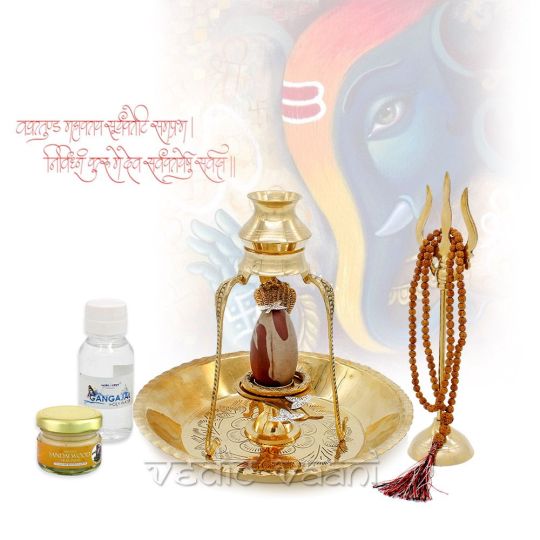

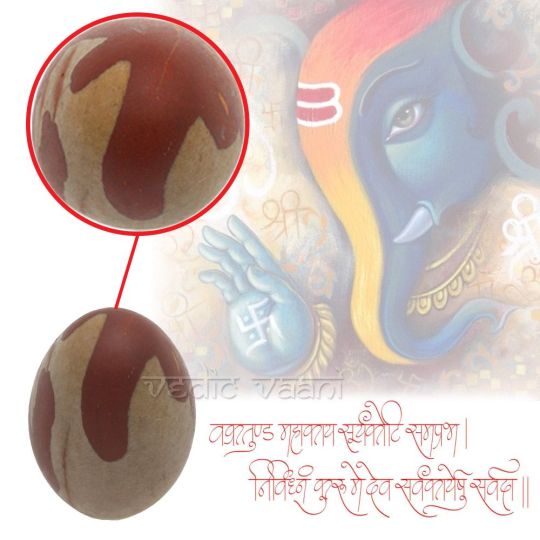

Significiant of Abhishek: Abhishek is a religious ceremony of holy bath given to a deity. The word abhishek means a sprinkling. It is derived from the root sic, to wet, and with the prefix abhi, "around," Abhisheka is literally, "wetting around." An Abhishek is the bathing part of a puja that usually is done with sacred water. In puja, a deity is called, seated, greeted, bathed, dressed, fed and praised. The bathing of the deity is the ABHISHEKA part of the puja. During an elaborate bathing ceremony a deity is bathed not only in water, but also with milk, yogurt, butter milk, honey, clarified butter, sugar, and all kinds of fruit juices. After this bathing, the sacred image is dressed, ornamented, fed and praised with hymns accompanied with bells, drums and other instruments. Offering Sugar cane juice, for example, help please the Goddess of wealth Laxmi. The various other offerings have different meaning and gives different results to the devotee. Offering honey may bring riches and financial gains, milk would help a person attain a baby boy, ghee is offered to expand your family lineage and have a fulfilling life, offering Ganga water would help devotees to attain Moksha, and pure water Abhishek would help remove troubles from ones life and fulfill special wishes. Thus, one should be aware of the type of Abhishek you wish to offer and the kind of blessings you wish to gain. Offering Abhishek is of grave importance and has a lot of prominence in Hindu culture. It pleases the almighty, brings peace of mind and makes one realize of the purpose of life. One becomes more open to embrace life and the realities associated with it.
Dimensions: Total Height of Set: 8.5 inches (23 cms approx) Shiv Lingam Height: 3.25 inches (7 cms approx) Centre Diameter of Lingam: 1.5 inches (3.5 cms approx) Yoni height upto snake: 5.75 inches (H) x 2.5 inches (W) x 4.5 inches (L) (13 x 6 x 12 cms approx) Brass Plate: 10 inches x 10 inches (25 x 25 cms approx) Trishul: 9 inches (H) x 2 inches (W) Rudraksha japa mala: 108+1 beads Gangajal: 50 ml Chandan tilak paste: 50 gms Total Weight of Set: 1 kg.
Get this product online so visit our website:
Vedic Vaani: https://www.vedicvaani.com
Facebook: https://www.facebook.com/VedicVaani/
Tumblr: https://vedicvaani.tumblr.com/
Instagram: https://www.instagram.com/vedicvani/
Linkdin: https://www.linkedin.com/in/vedic-vaani/
Pintrest: https://in.pinterest.com/vedicvaani/
#vedicvaani#shivabanalingamset#withtrishuls#shivabanalingam#shivabanalingamsetwithtrishuls#abhishektripod#banalingam#abhishektripodset#abhishekpatra#Shiva#lingam#rudrakshamala#chandanpaste#gangajal#forabhishek#ofshivligam#lingampuja#hurryshop#onlinestore
1 note
·
View note
Text
Solomon’s Song
The amatory drift of Solomon’s song is undisguised, 26though the language is dressed in the habiliments of seeming decency. The burden of thought of most of it bears direct reference to the Linga-Yoni. He makes a woman say, “He shall lie all night betwixt my breasts” (S. of S. i. 13). Again, of the Phallus, or Linga, she says, “I will go up the palm-tree, I will take hold of the boughs thereof” (vii. 8). Palm-tree and boughs are euphemisms of the male genitals. [26]
Phallic Worship by Hargrave Jennings
0 notes
Photo

Aruṇagiri Yogīśvara materialised and gifted The Young Avatār this stone Yoni (The base of a Shiva Linga) along with His Ātmalinga (Shiva Linga initiated and given by one's Guru, that is worn on the body continuously except while offering pūja to it). The Supreme Pontiff of Hinduism offered puja (worship) for this linga regularly until the year 2000 when He had the experience of the Avataric Realization and He let go of the linga in the Narmada River. The Atma Linga is the miniature of Cosmos and is energized and gifted by the guru, the Supreme Pontiff of Hinduism who is the personified Cosmic Energy. Atma Linga is our very own ātma, Consciousness. It holds tremendous power to manifest anything we want in our lives. The crystal linga is Paramashiva, the Sri Yantra on the top is Parashakkti, and the Bindu at the center of the Sri Yantra is the Guru. When we worship our Atma Linga - Paramashiva, Parashakti and Guru – we are directly connecting and tuning to our highest self or ātma. In Chapter 4 of the Agnikarya Vidhi Sloka, revealed by Bhagavan Paramashiva to Nandisvara, He reveals the details on Atma Linga: विधिना पूजिता लिङ्गे येनाऽहं भक्तिभावतः । तस्मै ददामि सालोक्यमलभ्यमन्यथा जनैः ॥ १६ ॥ vidhinā pūjitā liṅge yenā'haṃ bhaktibhāvataḥ । tasmai dadāmi sālokyamalabhyamanyathā janaiḥ ॥ 16 ॥ युस्त लिङे यन्त्रराजं विलिख्य पूजयेच्च माम् । तत्फलं चक्रराजाऽर्चाकोटिजगुणं भवेत् ॥ १७ ॥ yusta liṅe yantrarājaṃ vilikhya pūjayecca mām । tatphalaṃ cakrarājā'rcākoṭijaguṇaṃ bhavet ॥ 17 || To him, who with devotion worships Me properly in a Linga, I will grant a dwelling in My abode which is unattainable by others He who worships Me in the king of yantras, Śrīcakra inscribed on the Linga will attain to crores and crores of benefit of worshipping a Śricakrā. (at Golfutar, Budhanilkantha) https://www.instagram.com/p/CJ2sPTSgDxj/?igshid=100k0bploy57o
0 notes
Text
Unsolved Mystery of 9 Most Bizarre Temples of India

India is a country of temples with a great history. This country has one of the oldest civilizations all over the world. As there are numerous temples across the country, also some of them are mysterious and bizarre as India has 5000-year-old civilization, history, and culture of diversity and complexity. Also, in India, There are many things that science can't understand and explain. There is a bunch of lists of temples in India that are still unsolved. In India, people believe in gods according to their culture and every culture has there own religion and belonging. To find a mysterious temple is not a difficult task, and if you found a bizarre temple, then simply don't enter in the temple. There would be a lot of rituals, odd and un-unusual stuff going inside the shrine. Some of the temples are even 2000 years old, and some conduct there own exorcism rituals that are heavily forbidden for an outsider. If someone is suffering from an unusual kind of supernatural stuff or evil material, those people from across the country visit these temples. It is not that only evil possessed people to visit these temples, but the healthy individual also visits. But the frequency of unusual people is always high. So let's see nine most mysterious and bizarre temple of India whose mystery is still unsolved:
1. Jam Sawali Hanuman Mandir
The Jam Sawali Hanuman Mandir is one of three places where lord Hanuman is in a sleeping form. The temple is especially famous for conducting an exorcism. Thousands of devotees come here every day, particularly on Tuesday and Saturday as these days are memorable as worship for Lord Hanuman.

Image credit: facebook.com Individuals who are suffering from mental and health issues visit this temple, in Madhya Pradesh. The structure of Lord Hanuman is approx 15 feet long. All the devotees have to drink holy water, as prasadam. This holy water comes directly from the navel of the sculpture of Lord Hanuman, and it continuously flows.
2. Mehandipur Balaji Temple
In today's 21st century, there are still many temples in India that are still mysterious and full of strange things. Lots of devotee turns up here to get rid themselves of evil spirits and demons. The temple is present in the Dausa district in Rajasthan. Geography of the temple is weird, the campus and the temple are between two mountains. The exorcism done by the priest is very dangerous and brutal.

Image credit: newsable.asianetnews.com Here all devotees need to follow several types of rituals and customs if they want to get rid of evil spirits. People cant take anything from the temple premise; otherwise, it is said that evil spirits will start to follow you. Another important thing to remember is that while leaving the premise, never look back if someone takes your name. Just walk outside the premise. Also read: Bhangarh : The haunted fort in India
3. Padmanabhaswamy Temple
This is a Hindu Temple in Kerala and built in the 6th century A.D. The atmosphere of the temple is full of devotion and worship. But no one believed that the temple is the wealthiest in India. Until 2011 when someone filled a petition regarding the treasure present inside the temple.

Image credit: hight3ch.com After the supreme court ordered, all the search and exploration have been carried out. The government found that there is a total of six massive and secrets gates that contains treasure. All the gates open, but the vault B gate is still locked with some mantra and has an image of a serpent. And only a saint with high value can open this.
4. Kamakhya Temple
The Kamakhya temple is the temple of the goddess Kamakhya, and it is one of the oldest of 51 shakti pithas. It is situated on the Nilachal Hills in Assam. This place is also famous for its black magic and certain rituals. The black magic and special worship have been conducted here for decades.

Image credit: youtube.com In this temple, no sculpture or photo of the goddess is present; however, it contains a yoni or vagina-like a curve stone. The place is said to be the center of the entire universe. The temple is closed for three days each month because of the goddess menstruate. During this time, the structure is covered by a red cloth. All the guru's and saints come here to learn and worship black magic. Also read: Explore 20 Most Popular Religious Sites In India
5. Veerabhadra Temple
Veerabhadra Temple was built in the 16th century in Andhra Pradesh. The temple is one of the most notable examples of the architectural style of Vijaynagar. There are many attractions in the Veerabhadra Temple and contains the idol of Vishnu and Laxmi. It also has Ganesha, Shiva, Veerabhadra, Nandi.

Image credit: flickr.com In the premise, there is a structure of Nandi that has been carved with a single granite stone. And the main attraction is the Hanging Pillar, there are about 70 pillars of the 16th century. All the pillars are like normal pillars, but one of them represents a unique glimpse of architecture. The base of that particular pillar doesn't touch the ground. You can pass a thin piece of cloth from the pillar.
6. Stambheshwar Mahadev
The Stambheshwar Mahadev Temple is also known as the disappearing temple of Gujarat. This is a temple of shiva. It is the only temple in the country that submerges every day and then reappears. It is at the shore of the Arabian Sea, which looks amazing. Temple is 150 years old with extraordinary architectural looks.

Image credit: youtube.com In this temple, you will find Shiva Linga of 4 feet. The only way to visit this temple is when the tides are low in the sea. In high tides, the temple gets submerged. Devotee comes to worship; they stay here all day and starts to leave in the evening when the water starts to rise. Also read: 14 Most Famous Religious Festivals of India
7. Kal Bhairav Nath Temple
Kal Bhairav Nath temple is one of the most ancient temples of Lord Shiva. The temple is present in Varanasi. The temple has a strong connection and link with history, as it is in Varanasi. The exact period of construction of the temple is still unknown. Still, according to the history and holy books, it was constructed somewhere in 17th century A.D.

Image credit: en.wikipedia.org The idol here of Lord Shiva is a silver faced with an open mouth. The religious aspect of open mouth is that people and priests in the temple offer alcohol, wine, and whiskey. The alcohol is directly poured into the open mouth of Lord Shiva idol, and the rest are served as prasadam to the devotees.
8. Kodungallur Bhagavathy Temple
Kodungallur Bhagavanty Temple is also known as Sri Kurumba Bhagwati Temple. The temple is present in Kerala. This temple is listed as one of the most wonderful temples of South Indian. The temple is dedicated to the goddess Bhadrakali a form known of Maha Kali. The temple of Kodungallur witnesses a bizarre festival in March and April every year.

Image credit: dekochi.com The beginning of the festival is done with the sacrifice of cocks and then shedding of their blood. By moving further in this festival, men and women both wear red-colored apparel and start to run around the temple. And both men and women have swords, and they wave out it in the open air and revolves around the temple. All of these rituals are done to please the goddess Kali. Also read: Top Ten Historical Places In India
9. Venkateswara Temple
Even in this era of technology, some mysterious subjects should be explored with the help of technology and science. As this Venkateswara temple that is present in the district Chittoor of Andhra Pradesh. And it is also one of the richest and most mysterious temples of India. Even the geography of the temple is also very pleasant.

Image credit: scroll.in In terms of richness, this temple is one of the wealthiest temples in the world and devotees who visit here donate their hair for free. One of the most mysterious things about the temple is that the black statue of Lord Krishna and no one created it. This statue came out from the earth several years ago. Read the full article
0 notes
Photo

The Hindu god Shiva is worshipped in the form of linga, a stone that looks phallic, and sometimes sprouts out of a yoni, a representation of the vulva. Combined, this is symbolic of creation and regeneration of life, and ultimately fertility.
0 notes